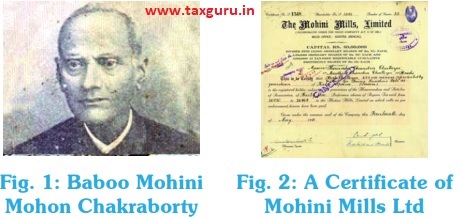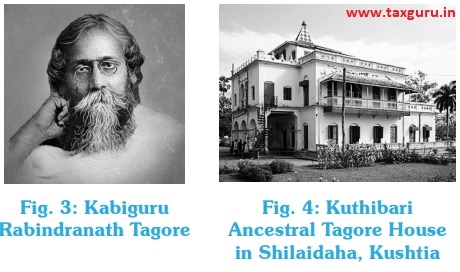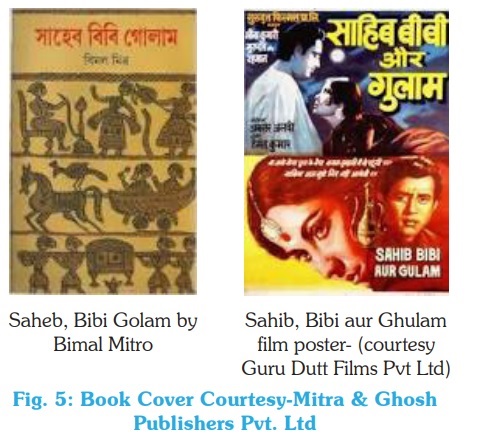Mr. Chandra Prakash Bhatia, IRS (IT: 2006)
Addl. CIT (ReAC) (Tech. Unit), Kolkata
chandra.p.bhatia@incometax.gov.in

Shri Chandra Prakash Bhatia, Additional Commissioner, is an IRS Officer of 2006 Batch. He has served in various units of Income Tax Department. He has been posted mostly in Bihar and Jharkhand and West Bengal. Though a science graduate, he has special interest in studying the ‘Medieval Financial History’. For last three years, he served in Gujarat and had a close view of the art, culture and history of this area. He is a member of the Editorial Board of Taxalogue. At present, he is posted as Additional Commissioner (Technical Unit), ReAC, Kolkata.
Executive Summary
Mohini Mills Limited was a commercial enterprise, established by Baboo Mohini Mohan Chakraborty after his retirement from Civil Service. It is a tale of entrepreneurship and out of box thinking of a bureaucrat. The enterprise boosted the Swadeshi movement in the country. It has set an example of development of indigenous industries in a very backward district. Baboo Mohini Mohan Chakraborty and his descendants made a notable contribution to the development of cotton textile industry and will be remembered as a milestone in financial history of India as well as Bangladesh. Apart from the financial history, Mohini Mills Limited, became immortal by signing its presence in art, literature and films. The article throws light on the glorious history of fabrics of Bengal as well history of Kushtia, which is now a district in Bangladesh. Kabuguru Rabindranath Tagore was once borne as a special nominee to the Board of this company. It is difficult to realize how the ordinary threads can weave a fantastic fabric called human life.
“A great brand is a story that is never completely told.”
—Scott Bedbury
Branding Consultant
In early 20th century Bengal, Mohini Mills Limited and its product became a household name in the erstwhile Bengal and held a place of pride in public psyche, breezed through the literature, films and traditions. Mohini Mills Limited was a commercial enterprise, in which poet-laureate Rabindranath Tagore was borne as a special nominee to the Board. Isn’t it strange that the name of the company found a mention in a great novel: Sahib, Bibi and Golam written by another great Bengali writer, Bimal Mitro.
Mohini Mohan Chakraborty, the founder of Mohini Mills Limited, was born in a pure Brahmin family at Elangi Para, Nadia (old) on 6 July 1838. His father, Krishnalal Chakraborty, was an employee of the Bengal Police Department. Mohini Mohan Chakraborty was the eldest of the five brothers and a sister. His performance at Government School in Burdwan from 1852 to 1857 was extraordinary. His first job was as a clerk in Kushtia sub-divisional office.
Sir Alexander McKenzie, Sub-Divisional Magistrate of Kushtia Sub-division, and Sir W. W. Hunter, a high ranking civil servant of Bengal, were impressed by Mohini Chakraborty’s work. Inspired and guided by such mentors, wheels of Mohini Baboo’s life began to run in fast lane. He appeared for the post of Deputy Magistrate and qualified. His first posting was as the Deputy Magistrate and judge of Noakhali. He was judicious and never convicted any accused unless full evidences required it. Once he had to face the wrath of superior, when despite Collector’s recommendation, he acquitted an employee, charged for embezzlement. As a District Magistrate, he was famous for his equitable and analytical presentation. He also served in Faridpur, Ara, Bhabhua and retired as District Magistrate of Bhagalpur.
On retirement, he was entitled to a handsome pension. Still beaming with energy, he ventured into the unchartered area of cotton industry. He pooled his lifelong savings and pension for the purpose of the cotton textile project in 1905#06. A wave of Swadeshi movement was sweeping India, resulting in development of indigenous industries. Baboo Mohini Mohan Chakraborty and later his descendants made a notable contribution to the cotton textile industry in Eastern India.
It may be pointed out that first modern cotton textile mill in Ahmedabad was set up by Ranchhodlal Chhotalal, a Gujarati, in 1858. Ranchhotlal Chhotalal had similarities to Baboo Mohini Mohan. Both were Brahmins and retired civil servants. Bengal entered in the cotton growing and processing quite late as compared to the Western India. Eastern India was quite competitive in some other industries as tea, jute, mining and metallurgy.
In 1905-06, Baboo Mohini Mohan Chakraborty started with eight looms in his home at Kushtia, in Nadia. The looms were driven with oil engines. In those days, especially in Eastern India, it was a bold venture for a first generation entrepreneur. He sent two of his sons to Ahmedabad and Bombay to learn techniques of the cotton textile industry. Kushtia had twin advantage of river travel as well as improved rail connectivity. A rail line from Calcutta to Kushtia was operative as early as in September 1862. Soon, in 1908, mill expanded over 100 acres of land in Milpara area. He imported 200 brass handloom machines and looms from England.
Three of his four sons were completely engaged in cotton industry as Managing Agents. One son was a lawyer in Bhagalpur Judges’ Court. The name of the sole proprietorship mill was CHAKRABORTY BROTHERS. Soon it was converted to a company, named Mohini Mills Limited. During the initial stage, two Gujaratis helped the company in managerial and marketing procedures. One was Keshavlalji Mehta and the other was Wadilalji Shah. The later was also a partner in Chakraborty Brothers for some time.
Mohlni Mill Ltd. was registered as a public limited company with a nominal capital of Rs. 1,50,000 divided into 600 shares of Rs. 25 each. Within six months of the registration, three-fourth of the share capital was purchased by the investors of Barisal, Sylhete, Dacca, Chittagaon (now all in Bangladesh), Patna and Rangoon. Investors of Kushtia, where the registered office was situated, were proud of it. In the first ordinary general meeting on the 18th August 1908, a Board of Directors was constituted, consisting of following 14 gentlemen, some were well known across the country.
TheseWere: Baboo Mohini Mohan Chakraborty, Madhab Chandra Roy, Behari Lal Sen, Kalidas Nandi, Chandramoy Sanyal, Chandicharan Chattopadhaya, Satyendra Nath Roy, Tara Pada Mazumdar, Gokul Chandra Mandal, Purna Chandra Roy (brother of Prafulla Chandra Roy) and Mahammed Rowson Khan Chowdhury. Three extraordinary members graced the board, namely, Raja Pramatha Bhushan Deb Roy Bahadur (a royal of Naldanga who had a large estate in Kushtia), Jagat Kishore Acharya (a zamindar of Mymensingh district) and Rabindra Nath Tagore1, who had a family estate there.
The mill produced 500 pairs of dhotis and sarees per day. The authorized capital was increased from Rs. 1,50,000 to Rs. 2,00,000 in 1910 and then to Rs. 6,00,000 in 1918. The company declared dividends continuously during 1912 to 1918, except for the year 1914–15. Mohini Mills produced fancy cotton goods, dhoties, sarees, bed-sheets, markins, twills, and hospital requisites such as bandages, and gauge cloths, as also grey and coloured yarns, many of which had a large demand in Bengal and outside. An efficient management and diversified products helped it achieve remarkable progress. The thick cloth made a niche product. The other competitors were Bang Laksmi Cotton Mills Ltd. and Dakeshwari Cotton Mills Limited.
In 1920, allowing advantage to the British goods, the government imposed the excise duty on Indian goods in a discriminatory manner. Such a tax was also detrimental to the growth of Swadeshi cotton industries. One of the worst victims was the hosiery industry where the government imposed a levy of excise duty on its products, despite the fact that hosiery factories had to pay import duty for yarns. Moreover, Mohini Mills had to pay a 5% customs duty on the ad valorem rate of yarn imported from Manchester including the weight of tubes also being included. As a result, the effective import duty was more than 5%. Despite this, it survived due to its goodwill and sound consumer support.

Within his mill complex, Mohini Baboo built a theatre called ‘Sandhya Samiti’ to entertain the employees. A library was established, keeping in line with the Bengali inclination for literature. A football team was also formed and at that time, the football team of Mohini Mill was skilled enough to compete with the Calcutta team.
Apart from Mohini Mills Limited, Kushtia has been famous for the Shrine of King of Bauls, Lalon Fakir (1774–1890) and Tagore’s ancestral house, named the ‘Kuthibari’. Poet-laureate Tagore lived here and wrote many unforgettable poems/stories like Sonar Tori, Katha o Kahini, Chitra, Chaitali, etc. while managing his zamindari. The ‘Kuthibari’ is now a museum.
In one of his famous poems, Bansi, Kabiguru has described how a male character is thinking of his dream girl, “In the yard, one who is waiting, she is wearing her ‘Dhakai Sari’, with vermilion on her forehead.”

Kushtia has a history of Indigo Resistance Movement. In 1835, Lord Macaulay had mentioned about it in a report to the Indian government. The cultivators narrated how oppressions were going on against them. J. Morris of Indian Civil Service came to investigate, since paying taxes was stopped. Lt. Governor Sir J.P. Grant recorded in his diary in 1860. Numerous cultivators in 1860 cultivated indigo. It spread in Bengal in 1860 and Shalghar Madhua organized the largest movement around Kushtia. The peasants of Jessore-Kushtia region revolted. Their leaders were Pari Sundari (a lady zamindar), Titu Mir and Haji Shariatullah. A folk-song of the nineteenth century depicts the mighty roles of these peasant leaders. Subsequently, with the publication of the Indigo Commission Report, an Act was passed prohibiting coercion of cultivators for indigo cultivation.
Before machine-made cotton arrived, the area was famous for jute and indigo. Surrounding places were well known for world-class luxury fabrics like ‘Muslin’ and ‘Jamdani sarees’. Henry Glassie, a famous researcher on folklore arts described Bengal’s weaving and embroidery, Jamdani is also popularly known as the Dhakai Saree. Description of such wonderful cloth is found in Chanakya’s Arthshashtra (3rd century BC) and the Greek book of a traveller’s account named Periplus of the Erythraean Sea. (Compiled between 1–3rd centuries).
Baboo Mohini Mohan Chakraborty died at the age of 84 in 1922. The mill marched ahead with increased capital and innovative products. It produced 1000 pairs of dhotis and sarees of different colours and varieties. The company set up modern machineries consisting of 10,000 spindles and 300 looms. A unit was established in the suburbs of Calcutta also, which produced items like dhotis, long cloth, sarees, mosquito nets, bed-sheets and shirting. All such products were immensely popular due to high quality and competitive pricing. Though Belgharia unit was larger, yet it was controlled from Kushtia Bazar, Nadia, its head office.
The annual statement of Mohini Mill for the year 1942 revealed that new modern machineries and equipments were installed in its factories No. 1 and No. 2. Despite Second World War, the company made profit worth Rs. 35.62 lakhs and paid dividend @ 25%. Its average rate of profit during the year 1938–55 was more than 13%. After the partition of Indian Dominion, its No. 1 Mill bearing the same name existed in Pakistan (Kushtia, now in Bangladesh) and No. 2 in Belgharia, Calcutta continued its work. Chakraborty Sons and Company was the managing agent with registered Office at 22, Canning Street (Biplabi Rash Behari Bose St.) Calcutta and exported goods to various countries like Pakistan, Nepal, Myanmar and Shri Lanka. After Independence, most of the units came under Eastern Pakistan.
At the peak of its journey, the authorized capital was Rs. 60 lakhs and subscribed capital was Rs. 59,98,818 and it had 48,460 total spindles and 975 looms and produced the different verities of clothes for the common needs. Upto 1963, the company operated in profit, and paid dividend and income-tax regularly. Mohini Mills Limited faced bad days in 1965, as a war broke out between India and Pakistan. It was declared an enemy (vested) property by Pakistan and owners were forced out of country. It was taken over along all its assets consisting of land, machinery, school, temple, playground, pond, market and hospital by Eastern Pakistan Industrial Development Corporation.
After creation of Bangladesh, Mohini Mills was nationalized and taken over by Bangladesh Textiles Mill Corporation and operated in loss. Bangladesh Government auctioned off the mill and it was renamed as Shah Makhdum Mill in 1985. In 1990 Government again took it over but the mill has failed to regain its past glory. People of Kushtia still take pride on its golden days.
Calcutta High Court records show details of a case, Mohini Mills Ltd. vs. Susama Debi and Ors. on 22 December 1924. Its citation is (1925) ILR 52 Cal 586. This case was preferred under Section 12 of the Companies Act 1913. It was presided over by the Bench having Justice J. Suhrawardy and Justice Cuming. The case was dismissed due to lack of jurisdiction. Justice J. Suhrawardy was the father of H.S. Suhrawardy, who became the fifth prime minister of Pakistan in 1956 and held office for about one year.
Every Bengali of that era had used the fabrics of Mohini Mills. During its golden period, it produced not only fabrics but also various items like ‘Sindoor’, used by Hindu women as a symbol of being happily married. The mill found a mention in the great novel named Shaheb, Bibi, Golam written by Bimal Mitro in 1953. Gurudutt produced a film on this novel, which was released in 1962. The story centres on Bhoothnath (Gurudutt) and Choti Bahu (Meena Kumari). Bhootnath (Gurudutt) is an accountant in Mohini Sindoor factory. In the film, Meena Kumari asks Gurudutt for ‘Mohini Sindoor’, which is believed to have the power to bring drifting men back to their wives. The role of Choti Bahu’s husband was played by Rahman. The film won many national awards.
Saheb, Bibi Golam by Sahib, Bibi aur Ghulam Bimal Mitro film poster- (courtesy Guru Dutt Films Pvt Ltd)

At present Mohini Mills in Bangladesh is inoperative and has huge outstanding liabilities. The bricks of Mill No. 2 at Belghoria, Kolkata are being stolen and sold at a premium on which word ‘Mohini’ in Bangla can be seen. The ghostly building seems to be weeping on its fate and people passing by appear oblivious of its past glory.
The film Sahib, Bibi aur Ghulam had melodious songs composed by Shakeel Badayuni. Songs were musically decorated by Hemant Kumar and sung by Asha Bhosle. In one of the dance song (आज मुझे नींद नहीं )आएगी,lines in third stanza seem to be describing the Mill’s present fate, “Kiski duniya yahan tabah nahi, Kaun hai jiske lab per aah nahi”.
Notes:-
1Swadesi Enterprises in Bengal, 1900–1920 by Amit Bhattacharya, 1986
Source- Taxalogue 3- April to June 2020






Kindly provide details of Purna Chandra Roy as I am great grandson of his. Purno Chandra Roy had two sons 1. Bijoy Roy an eminent lawyer of kushtia Courtpara Probably resided in Amlapara. Other brother was Binoy Roy.